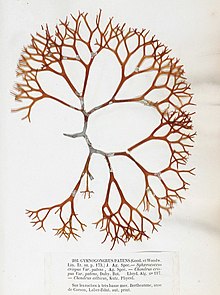
Lyngbya is a genus of cyanobacteria, unicellular autotrophs that form the basis of the oceanic food chain.

Cystophora is a genus of brown algae found mostly in temperate waters around Australia. Most of the southern Australian species can be immediately recognised as belonging to this genus by their characteristic zigzag branching pattern. Identification of individual species is generally more difficult and relies on the size and shape of branches, particularly terminal branches, which are specialised reproductive structures known as receptacles. Due to their local diversity and dominance in southern Australia, they are regarded by some as 'the eucalypts of the underwater world'.

Gracilaria, also known as irish moss or ogonori, is a genus of red algae in the family Gracilariaceae. It is notable for its economic importance as an agarophyte meaning that it is used to make agar, as well as its use as a food for humans and various species of shellfish. Various species in the genus are cultivated among Asia, South America, Africa and Oceania. They produce over 90% of the world's agar.

Dictyotales is a large order in the brown algae containing the single family Dictyotaceae. Members of this order generally prefer warmer waters than other brown algae, and are prevalent in tropical and subtropical waters thanks to their many chemical defenses to ward off grazers. They display an isomorphic haplodiploid life cycle and are characterized by vegetative growth through a single apical cell. One genus in this order, Padina, is the only calcareous member of the brown algae.

Nitella is a genus of charophyte green algae in the family Characeae.

Rhodymenia is a genus of red algae, containing the following species:

Plocamium is a genus of red algae in the family Plocamiaceae. It contains around 40 species and has a cosmopolitan distribution in temperate seas, although it is most diverse in the southern hemisphere. It is widely distributed in tropical and also warm-temperate and cold-temperate seas, such as northern Europe, the northern Arabian Sea and western Australia. They are also found in the Antarctic regions of Admiralty Bay and Terra Nova Bay.

Laurencia is a genus of red algae that grow in temperate and tropical shore areas, in littoral to sublittoral habitats, at depths up to 65 m (213 ft).
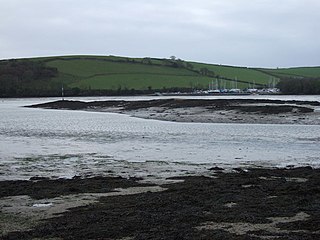
Chondria is a red alga genus in the family Rhodomelaceae.

Desmarestia is a genus of brown algae found worldwide. It is also called acid weed, acidweed, oseille de mer, sea sorrel, ウルシグサ, stacheltang, mermaid's hair, landlady's wig, or gruagach. However, 'sea sorrel' can also specifically refer to Desmarestia viridis. Members of this genus can be either annual or perennial. Annual members of this genus store sulfuric acid in intracellular vacuoles. When exposed to air they release the acid, thereby destroying themselves and nearby seaweeds in the process. They are found in shallow intertidal zones.
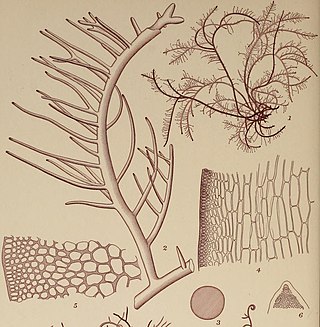
Hypnea is a genus of red algae, and a well known carrageenophyte.

Phyllophora is a genus of red algae in the family Phyllophoraceae.

Dictyota is a genus of brown seaweed in the family Dictyotaceae. Species are predominantly found in tropical and subtropical seas, and are known to contain numerous chemicals (diterpenes) which have potential medicinal value. As at the end of 2017, some 237 different diterpenes had been identified from across the genus.
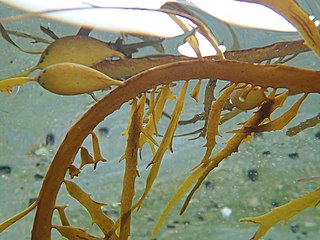
Phyllospora is a genus of seaweeds in the family Seirococcaceae.
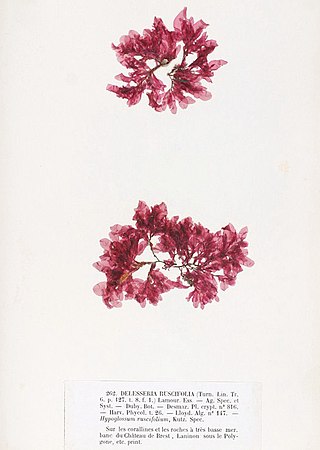
Apoglossum is a genus of red algae belonging to the family Delesseriaceae.
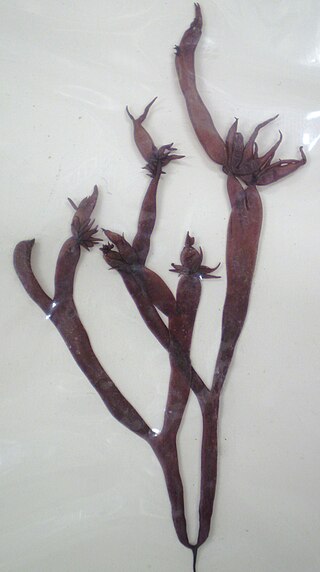
Gloiopeltis is a genus of red algae belonging to the family Endocladiaceae.

Carpophyllum is a genus of brown algae belonging to the family Sargassaceae.
